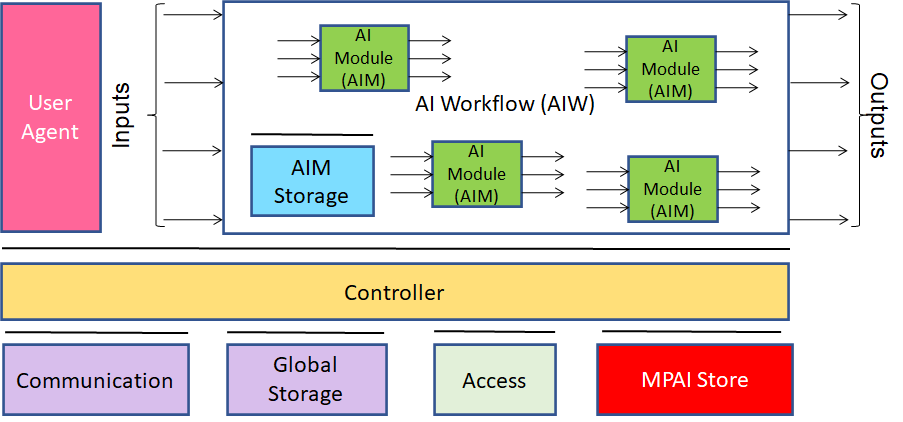In recent years, Artificial Intelligence (AI) and related technologies have been introduced in a broad range of applications, have started affecting the life of millions of people and are expected to do so even more in the future. As digital media standards have positively influenced industry and billions of people, so AI-based data coding standards are expected to have a similar positive impact. Indeed, research has shown that data coding with AI-based technologies is generally more efficient than with existing technologies for, e.g., compression and feature-based description.
However, some AI technologies may carry inherent risks, e.g., in terms of bias toward some classes of users. Therefore, the need for standardisation is more important and urgent than ever.
The international, unaffiliated, not-for-profit MPAI – Moving Picture, Audio and Data Coding by Artificial Intelligence Standards Developing Organisation has the mission to develop AI-enabled data coding standards. MPAI Application Standards enable the development of AI-based products, applications, and services.
As a rule, MPAI standards include four documents: Technical Specification, Reference Software Specifications, Conformance Testing Specifications, and Performance Assessment Specifications. Sometimes Technical Reports are produced to provide informative guidance in specific areas for which the development of standards in premature.
Performance Assessment Specifications include standard operating procedures to enable users of MPAI Implementations to make informed decision about their applicability based on the notion of Performance, defined as a set of attributes characterising a reliable and trustworthy implementation.
In the following, Terms beginning with a capital letter are defined in Table 1 if they are specific to this Standard and in Table 4 if they are common to all MPAI Standards.
In general, MPAI Application Standards are defined as aggregations – called AI Workflows (AIW) – of processing elements – called AI Modules (AIM) – executed in an AI Framework (AIF). MPAI defines Interoperability as the ability to replace an AIW or an AIM Implementation with a functionally equivalent Implementation.
MPAI also defines 3 Interoperability Levels of an AIF that executes an AIW. The AIW and its AIMs may have 3 Levels:
Level 1 – Implementer-specific and satisfying the MPAI-AIF Standard.
Level 2 – Specified by an MPAI Application Standard.
Level 3 – Specified by an MPAI Application Standard and certified by a Performance Assessor.
MPAI offers Users access to the promised benefits of AI with a guarantee of increased transparency, trust and reliability as the Interoperability Level of an Implementation moves from 1 to 3. Additional information on Interoperability Levels is provided in reference [4].
Figure 1 depicts the MPAI-AIF Reference Model under which Implementations of MPAI Application Standards and user-defined MPAI-AIF Conforming applications operate. MPAI is currently developing MPAI-AIF V2 that will compatibly extend MPAI-AIF V1 with security support.

Figure 1 – The AI Framework (AIF) Reference Model and its Components
MPAI Application Standards normatively specify the Syntax and Semantics of the input and output data and the Function of the AIW and the AIMs, and the Connections between and among the AIMs of an AIW.
In particular, an AIM is defined by its Function and data, but not by its internal architecture, which may be based on AI or data processing, and implemented in software, hardware or hybrid software and hardware technologies.
MPAI Standards are designed to enable a User to obtain, via standard protocols, an Implementation of an AIW and of the set of corresponding AIMs, and execute it in an AIF Implementation. The MPAI Store in Figure 1 is an entity from which Implementations are downloaded. MPAI Standards assume that the AIF, AIW, and AIM Implementations may have been developed by independent implementers. A necessary condition for this to be possible, is that any AIF, AIW, and AIM implementations be uniquely identified. MPAI has appointed an ImplementerID Registration Authority (IIDRA) to assign unique ImplementerIDs (IID) to Implementers.[1]
A necessary condition to make possible the operations described in the paragraph above is the existence of an ecosystem composed of Conformance Testers, Performance Assessors, an instance of the IIDRA and of the MPAI Store. Reference [4] provides an informative example of such ecosystem.
The chapters and the annexes of this Technical Specification are Normative, unless they are labelled as Informative.
[1] At the time of publication of this standard, the MPAI Store was assigned as the IIDRA.

